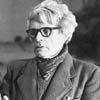Your shopping cart is empty!
Select currency
MENU

Leon George Claude Underwood (1890-1975) worked in several media - as linocutter, painter, etcher, wood-engraver and sculptor; he also taught and wrote extensively on the philosophy and theory of art.
Leon Underwood was born in London, eldest child to Theodore George Black Underwood, a print dealer and numismatist, and his wife Rose Ellen Cornelius who supplemented the family income as a dressmaker. After school Leon Underwood joined his father at their shop in Praed Street, his duties mainly the copying and repairing of prints. In this capacity he first encountered the work of Samuel Palmer and of Blake, and Blake, particularly, was to have a life-long influence on his work.
An exceptionally gifted sketcher, Leon Underwood was awarded a scholarship to the Royal Academy where he studied life-drawing under the tutelage of E.C. Alston, and painting under Gerald Moira (1910-13). As a student he visited Fry’s (1910) Post-Impressionist exhibition at the Grafton Galleries, and whilst he was enthralled by the use of colour, he judged the work neglectful of content. With this assessment Leon Underwood was already positioning himself against the prevailing aesthetic trends: he felt, and would feel increasingly, that a neglect of subject matter was to the detriment of art, and that the embrace of abstraction for its own sake simply led to greater and greater differentiation between art and artists and an ordinary life as lived by the majority.
After a brief time teaching drawing at the Royal Academy (where his pupils included Barbara Hepworth) Leon Underwood moved to what would become his life-long home and studio at 12 Girdler’s Road, off Brook Green, Hammersmith (1919). Here he opened The Brook Green School of Drawing and taught some of the most gifted students of the interwar generation: Henry Moore, Eileen Agar, Blair Hughes-Stanton, and Gertrude Hermes. >From here, too, emerged the Society of Wood Engravers (1925) and also a short-lived review, ‘The Island’, which canvassed some of his own and his students’ art works, and wherein Leon Underwood would publish some of his writings.
Leon Underwood wrote many articles and several books: ‘Animalia’ - a book of verse, and a novel, ‘The Siamese Cat’ – both books illustrated with woodcuts. He also wrote the treatise ‘Art for Heaven’s Sake: Notes on the Philosophy of Art To-Day’ (1934). He travelled widely, visiting Iceland, the cave paintings of Altamira in France, and Aztec and Mayan remains in Mexico; and during these travels he became fascinated with primitive art. In ‘Art for Heaven’s Sake’ he argues that whilst abstract artists often turn to the primitive for inspiration, they as often miss its essential point: that it communicates to the masses, and does so with so much impact mainly because it avoids abstraction and concentrates instead upon subject matter.
Leon Underwood’s work was exhibited at the Chenil Galleries, Chelsea (1920’s); the Alpine Club Gallery (1924); the Leicester Galleries, London (1934) and a retrospective took place at the Minories, Colchester (1969). He was a member of the Society of Wood Engravers; an Honorary Fellow of the Royal Society of British Sculptors, and in 1961 he received the Jean Masson Medal from the Society of Portrait Sculptors. He died in London (1975). His work is held in major public collections including the Victoria and Albert Museum, London, and the Ashmolean Museum, Oxford.
The Tate, London; the Victoria and Albert Museum, London; the Ashmolean Museum, Oxford; the National Museum and Gallery of Wales, Cardiff, and the British Council Art Collection, London.
This is a Limited Edition Giclee Print by the artist Leon Underwood 457mm x 613mm ..
£225.00 Ex Tax: £187.50